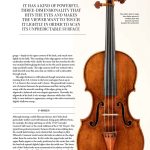The Strad magazine, April 2006 issue: The Genoese line
Copyright © 2006 Alberto Giordano – The Strad magazine. All rights reserved
The origins of violin making in Genoa lie in the first half of the 17th century, when lute and guitar makers, mostly of German origin, established a guild of instrument makers. No evidence remains of their work, but records imply that the city boasted a dynamic musical environment. The golden era of Genoese violin making, however, was the 18th century, when the city was alive with musical activity and around 1750 had a fair number of luthiers, among them Davide Pizzorno, Giuseppe Cavaleri, Bernardo Calcagno and Paolo Castello. By the turn of the 19th century the demand for new instruments decreased dramatically, probably because of the influx of cheaper French and German ones and the growth of the antiques market. There were now far fewer workshops, and the violin makers who remained concentrated on repair works.
It’s rare today to find a bowed instrument made in Genoa in the period 1800–30. Genoa lost its independence in 1815, at the end of the Napoleonic wars when the congress of Vienna annexed the old Republic of Genoa to the Kingdom of Sardinia and it deferred to the capital, Turin. The first makers in the 19th century to keep the violin making tradition alive were not of Genoese birth. Pierre Pacherel (1803–71), a collaborator of Giovanni Francesco Pressenda, was born in France and arrived in Genoa in 1827. Antonio Gibertini (1797–1866), born in Parma, was in Genoa between 1833–4 and 1845 and is an interesting and fine violin maker whose life and work remains obscure.
He knew Niccolò Paganini, as a result of which some of his violins were inspired by Paganini’s ‘Cannon’ Guarneri ‘del Gesù’ – he was one the few Italian makers of that period to copy Strads and Guarneris with great care and skill. The only luthier of that period to settle permanently in Genoa was Ludovico Rastelli (1801–78) from Piedmont, who arrived around 1835. Although dedicated mostly to repair work, he produced several violins, cellos and double basses, some decorated with extra purflings. He worked alone, helped in later life by his daughter Vincenza, one of the few female Italian violin makers of the 19th century.
During the mid 19th century Genoa underwent renewal and expanded beyond its medieval walls. Economic and social growth also led to the opening of the Genoa to Turin railway in 1853, which definitively linked the port to the capital. Turin maker Giuseppe Antonio Rocca took advantage of this opportunity for new business by opening up a shop in Genoa in the early 1850s – in via dei Sellai, close to the Teatro Carlo Felice. One of the probable reasons for his move was the Guadagnini family’s pre-eminence in Turin; Rocca nonetheless tried to maintain contact with his old Turin clients, moving from city to city until 1863, when he finally settled in Genoa for good. Rocca’s output in Genoa was consistent, including guitars and a few double basses along with the usual string quartet instruments. His two preferred violin models were the ‘Messiah’ Stradivari and the ‘Alard’ Guarneri ‘del Gesù’, but he never copied Paganini’s ‘Cannon’ Guarneri ‘del Gesù’, which was given to the city of Genoa in July 1851 and from 1859 was exhibited in a sealed glass dome; from the records concerning the instrument it seems that Rocca would never have had the opportunity to handle it.
The influence of Rocca’s personality on Genoese violin making was not very strong in his own time – he worked alone, with no assistants or pupils, and was helped by his son Enrico only after 1863; this collaboration was unexpectedly interrupted by Giuseppe’s death in 1865. The story of Italy in the 19th century is dominated by the Risorgimento, a movement born among the northern middle classes aspiring to the reunification of Italy.
Nicolò Bianchi (1803–80), a violinist and dancing master before he became a violin maker, is to be considered a true man of the Risorgimento for his patriotic and resourceful spirit. Although there is no precise information about his apprenticeship, it is known that he started seeking his fortune in France and in 1846 settled in Paris. In 1869 he returned to Genoa, finally moving to Nice in 1877. Bianchi was a man of modest education but of brilliant intelligence, with a modern approach to violin making: he was not only a maker and repairer, but also a dealer and connoisseur of classic Italian instruments.
From his voluminous correspondence we know that while in Paris he was in touch with some of the most famous soloists of his time – among them violinists Ferdinand David, Emile Sauret, Antonio Bazzini and Camillo Sivori, cellist Alfredo Piatti and double bassist Giovanni Bottesini – and repaired many important instruments by Stradivari, Guarneri ‘del Gesù’ and others. Bianchi was one of the few Italian makers in the 19th century to make antiqued instruments.
instruments reflects his strong personality, and the ageing technique he employed makes them easily recognisable. He trained important makers such as Giuseppe Scarampella, Eugenio Praga and probably the young Riccardo Antoniazzi; he also had a great influence on Erminio Montefiori (1841–1904), an interesting maker with enormous personality who copied 18th-century Genoese violins. In the last quarter of the 19th century, when the city was experiencing another period of urban and industrial expansion, the number of luthiers in Genoa increased and the popular neighbourhood of via Madre di Dio, where Paganini had lived, became the headquarters of many guitar and mandolin makers. However, despite a good supply of cheap plucked instruments, the Genoese market didn’t offer many opportunities for violin makers; moreover, there was a sort of order of precedence that had always been respected: when Bianchi left Genoa in 1877, the leading role was taken by his pupil Praga, who was not only a very gifted craftsman but also a wealthy gentleman, and who kept this position until his death; then the baton passed to Enrico Rocca, and finally to Cesare Candi. Eugenio Praga left his mark on Genoese violin making both through his skill and his close relationship with Paganini’s ‘Cannon’: he was the first maker to be asked to work on it. As a result, it inspired some of his own violins, all of which show good taste and an interesting balance between antiqued and unantiqued work.
Praga’s output was on the small side, with fewer than a hundred instruments, including violins, violas, a few cellos and a double bass, but the quality is always remarkable. There’s no evidence of pupils, but it seems highly likely that he had occasionally relied on the collaboration of Enrico Rocca, since there are many similarities in their technique and in the models used. These two makers lived very different lives: Praga was the son of an important family from Casale Monferrato (Piedmont) and took a masters degree in engineering in Florence before becoming a violin maker; whereas Enrico Rocca had quite a difficult life.
The loss of his father at the age of 19 forced him to run away from his family for good, and he worked as a boatman, a sailor, a ship carpenter and a woodworker. He opened his workshop in 1878 and made a living making hundreds of guitars and mandolins – only some years later did he start making violins with any regularity. This first period of his production is the most fascinating and least known, the instruments showing a certain eclecticism and a high technical level.
When Praga died (1901), Enrico Rocca became the pre-eminent violin maker in Genoa, taking the local market and even starting to sell abroad. His output and style remained consistent until his death. Although he used several different models, he had a predilection for Paganini’s ‘Cannon’ and later for the ‘Messiah’ Strad used by his father. It’s difficult to glean what kind of a relationship he had with his father and what he may have learnt from him; his making technique was certainly different, and closer to Praga’s. Surviving interviews and what we know of the life he led show him to have been something of a working-class hero, a simple and sharp man who claimed to be a true Genoese.
His simple and direct style had a strong influence on the later generation of Genoese violin makers. The Candi brothers, although trained in Raffaele Fiorini’s Bolognese workshop, took great inspiration from Rocca’s work, especially in the finishing of ‘modern’ instruments. The turn of the century saw a period of great change in violin making: makers started working in a more precise way – the ‘modern’ violin was supposed to be perfectly designed, sharply cut, flawlessy varnished. This change in taste may have had its origins in the Industrial Revolution and in the competitive attitude of makers encouraged by the universal exhibitions that flourished in Europe in the last quarter of the 19th century.
Cesare Candi is representative of this new generation of violin makers; arriving in Genoa in 1888, he joined his brother Oreste (1865–1938), who had been working for a few years for the plucked-instrument making firm Fratelli Barberis. Cesare’s career blossomed quite quickly: after winning a gold medal at the Genoa Exhibition of 1892 for a decorated mandolin, he was encouraged by Praga to work independently. Cesare Candi can be considered an innovator among Genoese violin makers. He abandoned the internal mould, which had been used in the city since the 18th century, for the external mould that he had encountered in Fiorini’s workshop, and his experience as a guitar maker led him to prefer the use of continuous linings, which made for swifter construction of the violin’s rib-structure. Artistically talented from childhood, Candi attained a high level of skill that can be admired in many decorated instruments made throughout his career; he was a designer and a sculptor and even his ‘normal’ instruments were entirely drawn by him.
Candi left a permanent imprint on both professional and amateur 20th-century Genoese violin making. Paolo de Barbieri entered Candi’s workshop when he was about 30, having previously been a sailor and soldier. He learnt external mould construction from Candi, as well as the use of continuous linings, which he employed throughout his life. He made more than 360 violins, as well as violas, cellos and guitars. In his early period he used his master’s Strad model, followed later by a personal Strad model with narrow f-holes and round archings; but his main model was the ‘Cannon’ Guarneri ‘del Gesù’, which since Praga had been a steady reference for all Genoese makers.
De Barbieri’s place in Candi’s workshop was taken in 1924 by a talented young woodworker called Giuseppe Bernardo Lecchi (1895–1967), originally from a southern Piedmontese village. Lecchi proved the ideal partner for Candi and made a considerable contribution to his last series of decorated instruments, taking charge of the delicate inlays. When in 1937 he won first prize for a quartet at the Stradivari bicentennial exhibition in Cremona, Lecchi was at his peak. His was a more ‘classical’ taste than that of all the other Genoese makers, and his way of making the Stradivari model was elegant and well balanced. Most of his violins don’t bear the sharp edges and consistent archings of modern Genoese instruments. Lecchi used Candi’s continuous lining technique only in his early period; soon after he began making the interiors in the traditional way, with the central linings mortised or simply set into the centre-blocks.
Lastly, mention must be made of Oreste Candi’s only pupil, Lorenzo Bellafontana, whose production of bowed instruments is not consistent, interspersed as it is with many guitars and repair works, but is nonetheless interesting for the great changes in style that those instruments show. During the 1950s he made a fair number of ‘Cannon’ violins in the style of Praga that sometimes bear original labels. Evidently the tradition of violin making in Genoa continued unbroken, which is more than can be said of similar traditions in many other Italian cities; on the other hand, style, making techniques and tastes changed over the generations.
The single factor that seems to link modern times with the past is a dark, bewitching violin that for around 150 years has lain in the city’s town hall: Paganini’s ‘Cannon’ is the true thread, the obligatory reference point not only for every maker who has considered this violin as a starting point, but also for those makers (like Cesare Candi) who respectfully kept their distance.
The Strad, april 2006




